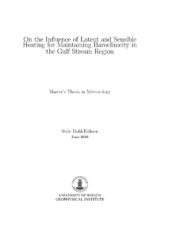On the Influence of Latent and Sensible Heating for Maintaining Baroclinicity in the Gulf Stream Region
Master thesis
Permanent lenke
https://hdl.handle.net/1956/12646Utgivelsesdato
2016-06-01Metadata
Vis full innførselSamlinger
- Geophysical Institute [1198]
Sammendrag
For the North Atlantic storm track to collocate with the ocean front, there has to be efficient restoring mechanisms for baroclinicity. The total diabatic heating is agreed to play the most dominant role, but whether the differential surface sensible heat fluxes or the latent heat release have the strongest impact, is still an ongoing discussion. This study presents a synoptic comparison between intense surface sensible heat fluxes and latent heating in the Gulf Stream region. During two winter seasons, 2008-2010, the findings show that intense latent heat release is strongly connected to the warm sector of extratropical cyclones. This study also shows that intense surface sensible heat fluxes are highly influenced by a persistent anticyclonic pattern over the North American continent prior to their peak. The latter indicates that anticyclones also contribute to strong surface sensible heat fluxes and possibly help to maintain baroclinicity in the Gulf Stream region. When using the slope of an isentropic surface as a proxy for baroclinicity, it is found that an increase in the surface sensible heat fluxes is followed by a low tropospheric steepening of the net isentropic slope. The latent heat release does not influence the net isentropic slope in the same distinct way, but when investigating its tendency to increase the slope, the latent heat release shows positive contributions above 900 hPa. The overall findings indicate that both surface sensible heat fluxes and latent heating restore baroclinicity in the Gulf Stream region, with the former showing strongest indications.
